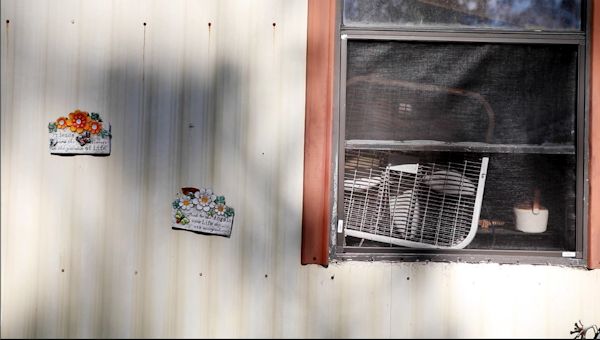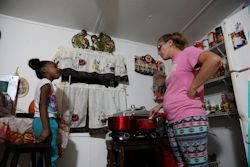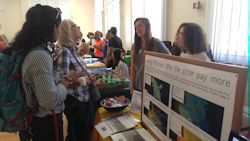SEJournal Online is the digital news magazine of the Society of Environmental Journalists. Learn more about SEJournal Online, including submission, subscription and advertising information.
 |
| Energy Burden, a five-day series investigating the intersection of energy and poverty, was the work of students in environmental journalism class at the University of Florida. This window frame became the project's front page and logo. Photo: Drea Cornejo. |
EJ Academy: How a Hurricane Whipped Up Student Energy/Poverty Project
By Cynthia Barnett
Students who enroll in environmental journalism class at the University of Florida show up hoping to report on manatees, longleaf pine forests or the iconic local freshwater springs. And they often do.
But those in the fall 2017 course were confronted instead with utility, housing and poverty data.
 |
| "You're constantly telling your kids 'no' because you have this outrageous, $1,000 electric bill," said Heather King, who lives with her family in a small trailer with no air conditioning yet faces routinely high utility bills. The student project “Energy Burden” found Gainesville's lowest-income residents spend an average 22 percent of income on utilities. Photo: Drea Cornejo. |
By semester’s end, they’d lived through and reported on a hurricane, knocked on doors in Gainesville neighborhoods they didn’t know existed, and published a five-day series, “Energy Burden,” that exposed a shocking level of power inequality in their college town.
As a practicing environmental journalist with a part-time appointment at UF’s College of Journalism and Communications, I developed an EJ course in 2015 that’s open each time to 10 undergrads and 10 graduate students.
This past fall, I made “energy and poverty” the theme of the course after an education professor who volunteers in high-poverty neighborhoods told me that some of the poorest families in our town pay more for utilities than for rent because of appalling housing inefficiency.
The course was assisted by professors across campus who lectured in class and helped the students sift through databases. Students analyzed energy consumption and cost data from our local utility; property appraiser records showing housing square footage and value and whether properties have air conditioners; and income and other data from the U.S. Decennial Census and American Community Survey.
Data, families behind energy inequity
The central finding was that Gainesville’s poorest citizens spend 22 percent of their income on utility bills, a far higher burden than the national average for the poor and more than quadruple what most in our community pay as a percentage of income.
From this starting point, students had to find and pitch their own stories, pursuing data and the real families behind it.
For instance, we learned that inefficient rental properties are a huge part of the problem, but almost all the government incentives and grant programs for efficiency upgrades are for homeowners. So we wanted to use the property appraiser records and utility costs database to find those properties with far higher energy use than their square footage would dictate.
But that turned out to be too complex for the time we had. Instead, we settled on code violations as one way to get at the kinds of problems — like gaping holes — that hike utility bills for low-income renters.
An undergraduate student, Bailey LeFever, made the public records requests for housing code violations, then used the database of addresses with the most violations to go knock on doors, which led her to just the sorts of problems with landlords we’d heard about.
Poor wait longer for power in wake of Irma
When Hurricane Irma tore through Gainesville in September, however, it changed the course of the stories and gave the project new urgency.
For example, the graduate student pursuing a story about Gainesville’s historic segregation of African American residents in flood-prone areas thought she saw a pattern as she watched power-restoration maps post on the local utility’s Twitter feed. Gainesville Regional Utilities later deleted those maps. The student, Joan Meiners, made a public-records request for time-stamped power restoration by address.
Their work seems to be making
a tangible difference in Gainesville’s
ongoing conversation about inequity.
After considerable negotiation for the data, her analysis found that, of those who lost power for at least a day, residents living in the lowest-value properties had to wait three times longer than average for the lights to come back on. Following the data down gravel roads, she found the astonishing story of the Williamses, an elderly disabled veteran and his wife who’d been without power or water for two months.
The reasons for the inequities stretch back to that history of settlement of African Americans in the flood-prone east side of Gainesville. But the students found again and again that current trends are continuing the disparities, rather than chipping away at them as we hope and assume. Buried power lines in the wealthier west is one example. The march of solar power to the western neighborhoods is another.
The project maps, created by another graduate student using the online data analyzation and visualization tool Carto, were among the most important elements of the series. They helped show that the places where people pay more for utilities, where they had to wait longer for power to be restored after the hurricane, where rental properties are substandard and where solar is not happening are all the same areas.
Final package yielded solutions-oriented stories
Twelve substantive stories — along with the maps, photographs and videos — became “Energy Burden,” a five-day series on WUFT.org, the digital home for the NPR and PBS affiliates at UF’s journalism school. As far as I know, we are the only journalists in Florida who analyzed the duration of power failures in the context of poverty.
 |
| University of Florida journalism majors Monica Humphries, right rear, and Summer Jarro, right front, answer questions about the project Energy Burden at an NAACP forum on energy and climate justice. Photo: Cynthia Barnett. |
Crucially, the final day’s stories are all solutions-oriented — carrying the themes forward to how we can do better, in everything from community solar to tiny houses to building Habitat for Humanity homes with efficiency as a priority.
My mistakes were many, including not requiring photographs and other assets on first draft, which would have helped make the visuals as strong as the stories. Meanwhile the opening weeks’ course materials and lectures on utility rates, housing efficiency and poverty were so arcane and different from what students look forward to in an environmental journalism class that some were overwhelmed. It took them half the semester to understand the relevance and find their own stories.
By the time deadlines rolled around we were drained and jangled. But in the end, I think the hurricane and other challenges brought most of the students together and inspired them to work that much harder.
Most importantly, their work seems to be making a tangible difference in Gainesville’s ongoing conversation about inequity. In February, the mayor called for better energy efficiency standards — especially for rentals — as part of a series of strategies to battle inequity in the city. Then in March, the local NAACP invited the student reporters to present their findings at a community forum organized by its Environmental and Climate Justice Committee.
Especially in our peculiar “post-truth” times, it’s been inspiring to see college students demonstrate the power of data-driven, yet human-centered, stories, to move leaders to action and increase understanding among the privileged in our college town of the lives and challenges of their neighbors.
SEJ member Cynthia Barnett is a long-time environmental journalist, the author of three popular books on water and an environmental journalist in residence at the UF College of Journalism and Communications in Gainesville, Fla.
* From the weekly news magazine SEJournal Online, Vol. 3, No. 16. Content from each new issue of SEJournal Online is available to the public via the SEJournal Online main page. Subscribe to the e-newsletter here. And see past issues of the SEJournal archived here.












 Advertisement
Advertisement 



